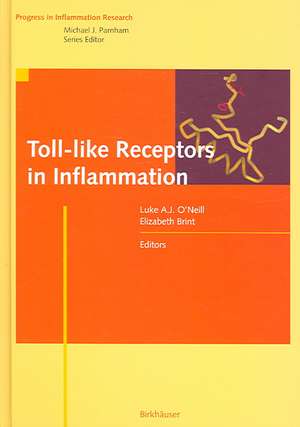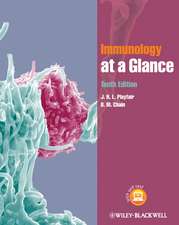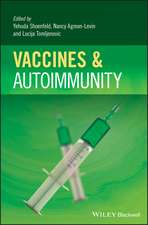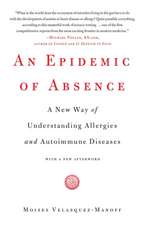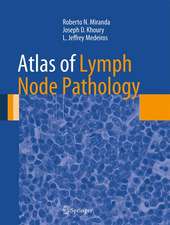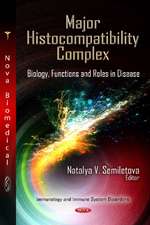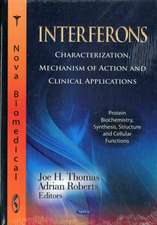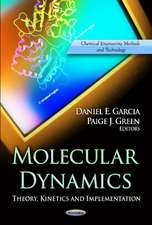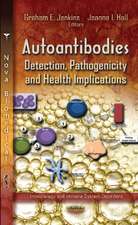Toll-like Receptors in Inflammation: Progress in Inflammation Research
Editat de Luke A. J. O'Neill, Elizabeth Brinten Limba Engleză Hardback – 9 dec 2005
Din seria Progress in Inflammation Research
- 5%
 Preț: 1615.04 lei
Preț: 1615.04 lei - 5%
 Preț: 1433.10 lei
Preț: 1433.10 lei - 5%
 Preț: 723.05 lei
Preț: 723.05 lei - 18%
 Preț: 950.21 lei
Preț: 950.21 lei - 15%
 Preț: 648.42 lei
Preț: 648.42 lei - 5%
 Preț: 1300.72 lei
Preț: 1300.72 lei - 5%
 Preț: 1103.95 lei
Preț: 1103.95 lei - 5%
 Preț: 1061.94 lei
Preț: 1061.94 lei - 5%
 Preț: 715.35 lei
Preț: 715.35 lei - 5%
 Preț: 1098.63 lei
Preț: 1098.63 lei - 5%
 Preț: 657.90 lei
Preț: 657.90 lei - 5%
 Preț: 717.93 lei
Preț: 717.93 lei - 5%
 Preț: 996.74 lei
Preț: 996.74 lei - 5%
 Preț: 1413.72 lei
Preț: 1413.72 lei - 5%
 Preț: 1102.46 lei
Preț: 1102.46 lei - 5%
 Preț: 1102.82 lei
Preț: 1102.82 lei - 5%
 Preț: 991.73 lei
Preț: 991.73 lei - 5%
 Preț: 1115.86 lei
Preț: 1115.86 lei - 5%
 Preț: 720.31 lei
Preț: 720.31 lei - 5%
 Preț: 1611.76 lei
Preț: 1611.76 lei - 5%
 Preț: 654.23 lei
Preț: 654.23 lei - 5%
 Preț: 1414.64 lei
Preț: 1414.64 lei - 5%
 Preț: 652.77 lei
Preț: 652.77 lei - 5%
 Preț: 1099.94 lei
Preț: 1099.94 lei - 5%
 Preț: 1856.59 lei
Preț: 1856.59 lei - 15%
 Preț: 644.95 lei
Preț: 644.95 lei - 5%
 Preț: 1108.72 lei
Preț: 1108.72 lei - 5%
 Preț: 658.46 lei
Preț: 658.46 lei - 5%
 Preț: 1108.51 lei
Preț: 1108.51 lei - 24%
 Preț: 801.40 lei
Preț: 801.40 lei - 5%
 Preț: 715.19 lei
Preț: 715.19 lei - 5%
 Preț: 1807.08 lei
Preț: 1807.08 lei - 5%
 Preț: 721.40 lei
Preț: 721.40 lei - 5%
 Preț: 991.73 lei
Preț: 991.73 lei - 5%
 Preț: 720.68 lei
Preț: 720.68 lei - 5%
 Preț: 1100.09 lei
Preț: 1100.09 lei - 15%
 Preț: 577.87 lei
Preț: 577.87 lei - 5%
 Preț: 652.77 lei
Preț: 652.77 lei - 5%
 Preț: 653.35 lei
Preț: 653.35 lei - 5%
 Preț: 650.25 lei
Preț: 650.25 lei - 5%
 Preț: 1116.73 lei
Preț: 1116.73 lei - 5%
 Preț: 1096.98 lei
Preț: 1096.98 lei - 5%
 Preț: 1412.62 lei
Preț: 1412.62 lei - 5%
 Preț: 1420.49 lei
Preț: 1420.49 lei - 5%
 Preț: 721.77 lei
Preț: 721.77 lei - 5%
 Preț: 1102.10 lei
Preț: 1102.10 lei - 5%
 Preț: 1099.20 lei
Preț: 1099.20 lei
Preț: 1102.10 lei
Preț vechi: 1160.10 lei
-5% Nou
Puncte Express: 1653
Preț estimativ în valută:
210.92€ • 219.38$ • 174.12£
210.92€ • 219.38$ • 174.12£
Carte tipărită la comandă
Livrare economică 14-28 aprilie
Preluare comenzi: 021 569.72.76
Specificații
ISBN-13: 9783764372859
ISBN-10: 3764372850
Pagini: 256
Ilustrații: XII, 246 p.
Dimensiuni: 170 x 244 x 20 mm
Greutate: 0.61 kg
Ediția:2005
Editura: Birkhäuser Basel
Colecția Birkhäuser
Seria Progress in Inflammation Research
Locul publicării:Basel, Switzerland
ISBN-10: 3764372850
Pagini: 256
Ilustrații: XII, 246 p.
Dimensiuni: 170 x 244 x 20 mm
Greutate: 0.61 kg
Ediția:2005
Editura: Birkhäuser Basel
Colecția Birkhäuser
Seria Progress in Inflammation Research
Locul publicării:Basel, Switzerland
Public țintă
ResearchCuprins
TLRs as bacterial sensors.- Toll-like receptors and rheumatoid arthritis: is there a connection?.- Toll-like receptor 9 and systemic autoimmune diseases.- Toll-like receptors and airway disease.- Toll-like receptors and vascular disease.- Toll-like receptors and inflammatory bowel disease.- Toll-like receptor signaling in the liver.- Toll-like receptors as key sensors of viral infection.- IRAK-4: A key kinase involved in toll-like receptor signaling and resistance to bacterial infection.- Endogenous regulation of toll-like receptor signalling.- Tuning of inflammatory cytokines and toll-like receptors by TIR8/SIGIRR, a member of the IL-1 receptor family with unique structure and regulation.- Toll-like receptors as pharmacological targets.
Textul de pe ultima copertă
Toll-like receptors (TLRs) are critical mediators of the innate immune response in mammals. This family of receptors recognizes a variety of microbial products or motifs and initiates the host response to infection. Examples include TLR4 which recognizes lipopolysaccharide (LPS) from Gram-negative bacteria, TLR3 which recognizes viral double-stranded RNA, and TLR9 which recognizes CpG DNA motifs, found in both viruses and bacteria. All TLRs possess an intracellular region termed the Toll-IL-1 receptor-Resistance (TIR) domain which is essential for signaling from these receptors. The specificity of signaling from individual TLRs arises from differential utilization of adapter proteins. This specificity results in a tailoring of the host defense response depending on the microbe being sensed. TLRs are increasingly being implicated in both infectious and inflammatory diseases, notable examples being sepsis, inflammatory bowel disease, atherosclerosis, and asthma. There is, therefore, great interest in targeting TLRs therapeutically since a disruption of TLR function will result in a decrease in the production of inflammatory mediators. This volume covers our current understanding of TLRs and their role in inflammation. Given the importance of TLRs in the inflammatory process and their emerging role in inflammatory diseases the book is of great interest to researchers working in inflammation and immunology.
Caracteristici
Written by leading scientists in the field Covers the current understanding of TLRs and their role in inflammatory diseases Gives outlook on the development of drugs Includes supplementary material: sn.pub/extras
